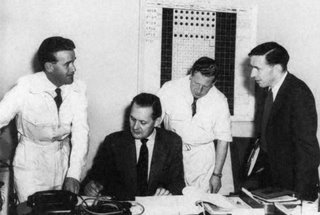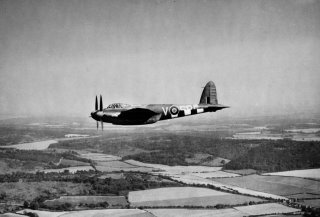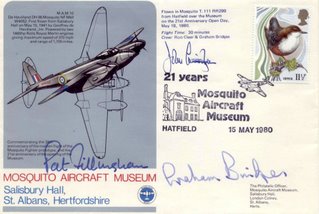William 'Pat' Patrick Ingram Fillingham 1914 -2003
 Pat Fillingham flying an early DH Chipmunk. He flew the maiden flight of the type
Pat Fillingham flying an early DH Chipmunk. He flew the maiden flight of the type Pat Fillingham seated with DeHavilland Flight Test Crew
Pat Fillingham seated with DeHavilland Flight Test Crew

William Patrick Ingram Fillingham was born at Sutton Coldfield in 1914. He was educated at Worksop College and the de Havilland Aeronautical Technical School. He learnt to fly in the RAF Volunteer Reserve at Perth, soloing in a Tiger Moth in February 1937 and qualifying for his RAF wings in November 1938. On graduating as an aeronautical engineer in 1939 he joined the de Havilland Aircraft Company as a junior test pilot.
War brought big orders for new production aircraft, each of which had to be meticulously flight-tested. By April 1940 he was making more than 150 flights a month, mostly clearing new Tiger Moths. By September 1942, as chief production test pilot, he was making 30 Mosquito sorties a month.
In 1943 de Havilland sent him to Toronto and Sydney, where additional production lines were now rolling out de Havilland’s formidable “unarmed bomber with fighter speed”. His job was to advise the local de Havilland companies on Mosquito flight-testing. While in Canada he demonstrated Toronto-built Mosquitoes at a dozen military air bases, helping to win a substantial USAAF order. Back in England, where Mosquito production was running at five aircraft a day, he found himself flying more than 100 Mosquito test sorties a month. He flew more than 2,200 Mosquito sorties, undoubtedly a record. In 1944 production of the DH103 Hornet — the world’s fastest propeller fighter — added to the workload. Though the Mosquito always remained his favourite aircraft, he so admired the Hornet that he once flew it wearing a bowler hat.
He was quite a reserved person, never giving interviews or making speeches, but colleagues unfailingly recall his sense of humour. In September 1940, when the Battle of Britain was raging overhead, the boffins asked him to test a new atmospheric instrument. This meant flying an unarmed Dominie biplane at 15,000ft over southern England. When his flight-test engineer asked what they were supposed to do if they encountered a Messerschmitt, Fillingham said: “Don’t worry, I’ll wave my Nazi armband” — which he duly wore.
Peace brought big export and home orders for Dove and Heron commercial transports, Chipmunk trainers and Vampire jet fighters. Mosquitoes and Hornets were also still rolling off the production lines, joining the queue for air tests, demonstrations, customer crew-training, ferry flights and customer deliveries. In 1947, back from his Chipmunk work in Canada, he logged each of those types in one month.
Later in the 1950s, as de Havilland struggled to recover from the Comet 1 disasters, Fillingham turned his skills to testing the modified and redesigned Comets. He flew RCAF Comet 1As, RAF Comet 2s, BOAC Comet 4s, BEA Comet 4Bs, Mexicana Comet 4Cs, and variants for export customers. He took particular pleasure in delivering BOAC’s first Comet 4s to Heathrow in September 1958. The following month one of these inaugurated the world’s first transatlantic jet services, beating Pan American’s Boeing 707s. When that plane was retired by Dan-Air, he flew it to the Duxford air museum.
After the Comet 4s came the Trident series of trijet airliners, which came off the Hatfield production line from 1963. The Trident was the fastest subsonic jet airliner ever, and the first to be certificated for automatic landings in zero visibility. Customer crew-training took Fillingham to many countries. His most notable assignment, in 1972, was the delivery of China’s first Western jet airliner. He and a fellow test pilot flew CAAC’s first Trident from Hatfield to Canton. His logbook records: “Acceptance, 2 Test Frights — crew unable to speak a word of English.” He made further visits to China, and trained Chinese crews.
He retired in 1975 as deputy chief test pilot of Hawker Siddeley Aviation (into which de Havilland had been merged). In the last years of his career he enjoyed shuttle-flying the company’s 125 executive jets around Europe, and displaying his beloved Mosquito T3 RR299 at air shows. When he made his last flight he had flown 11,450 hours and 120 different aircraft types, including such rarities as the Flamingo, Albatross, Defiant, Battle, Henley, Botha, Cirrus Moth, DH84 Dragon, Audax, Lysander, Mew Gull, Vengeance, Catalina and Queen Bee.
He owned several vintage cars including a Bentley. He took part in three Monte Carlo rallies with his father-in-law, the racing driver Mike Couper. He restored a 1928 Austin 7, designed and built a racing car with a Cooper 500 engine and collected antique clocks.
Fillingham was awarded the Queen’s Commendation for Valuable Service in the Air in 1970 and the Guild of Air Pilots and Air Navigators Derry and Richards Medal in 1973. Flying the Chipmunk G-AKND, he was British air racing champion in 1952 and winner of the Goodyear Trophy in 1952 and the King’s Cup in 1953. He was a Fellow of the Royal Aeronautical Society, which awarded him its RP Alston Memorial Medal, and a Master Air Pilot



<< Home